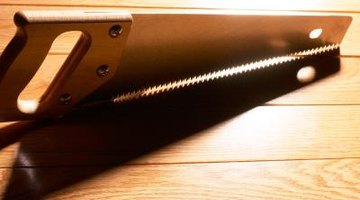Tools Used to Cut Conduit
Conduit is extremely hard and dense plastic formed in the shape of a tube and is most generally used in electrical and plumbing fields for wire or water/waste products to flow through. Cutting conduit is required in both fields when there is a piece that needs to be a certain length. Less common uses for conduit include making creative pieces. There are tools that are particularly useful for cutting conduit.
Handsaws

Handsaws are lightweight, portable and manageable. You can use a blade with anywhere from 18 to 32 teeth. This keeps the blade from binding up and breaking. To hold the conduit in place when using the handsaw, use a vise. It is better when cutting something rigid, like conduit, to place the blade in the handsaw with the teeth facing forward. Always cut conduit at a 90-degree angle. You can use cutting oil to help the process go smoother.
Powered Handsaw
A powered handsaw is also portable and manageable for use in cutting rigid conduit, though it is less lightweight. You should use a powered handsaw when you have a good deal of conduit to cut or many cuts to make. This keeps you from tiring out and helps you hold the blade at a 90-degree angle with the pipe. You should always wear safety goggles and follow all safety instructions regarding the powered handsaw to avoid injury to yourself or others. Holding the pipe with a vise is also recommended when using a powered handsaw.
Pipe Cutter
When cutting conduit, using a pipe cutter involves much less effort but more operation, and it is essential to place the pipe in an elevated vise. You must line the blade up with the cutting line, and tighten it until the blade comes into contact with the pipe. Tighten the blade once every turn, and keep turning until the conduit is cut completely through. Make sure to use cutting oil to help the process go faster.
Reamer
If you choose to use a pipe cutter to cut conduit, a reamer is an essential tool. The reamer's purpose is to remove the burrs left on the inside of the pipe. Burrs occur after using a pipe cutter and can snag wires that are run through the conduit. You use the reamer's handles to turn the reamer inside the conduit until the burrs are gone. You can also use an industrial-quality file to smooth out the edges after reaming. After you use the reamer, tap out the end of the conduit, and keep your reamer clean and in working condition.
References
Writer Bio
Paul Parsons is a freelance writer, living in Houston, Texas. Parsons writes from an array of different topics, but specializes in medical, personal finance, computers and business.
Photo Credits
- Hemera Technologies/Photos.com/Getty Images
More Articles



